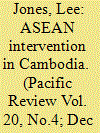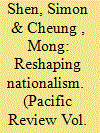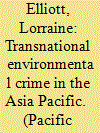|
|
|
Sort Order |
|
|
|
Items / Page
|
|
|
|
|
|
|
| Srl | Item |
| 1 |
ID:
080573


|
|
|
|
|
| Publication |
2007.
|
| Summary/Abstract |
Despite their other theoretical differences, virtually all scholars of the Association of Southeast Asian Nations (ASEAN) agree that the organization's members share an almost religious commitment to the norm of non-intervention. This article disrupts this consensus, arguing that ASEAN repeatedly intervened in Cambodia's internal political conflicts from 1979 to 1999, often with powerful and destructive effects. ASEAN's role in maintaining Khmer Rouge occupancy of Cambodia's UN seat, constructing a new coalition government in exile, manipulating Khmer refugee camps and informing the content of the Cambodian peace process will be explored, before turning to the 'creeping conditionality' for ASEAN membership imposed after the 1997 'coup' in Phnom Penh. The article argues for an analysis recognizing the political nature of intervention, and seeks to explain both the creation of non-intervention norms and specific violations of them as attempts by ASEAN elites to maintain their own illiberal, capitalist regimes against domestic and international political threats.
|
|
|
|
|
|
|
|
|
|
|
|
|
|
|
|
| 2 |
ID:
080574


|
|
|
|
|
| Publication |
2007.
|
| Summary/Abstract |
This article is an attempt to provide a corrective to a marked Sinocentrism in contemporary debates on regional integration in Asia. In order to do so, firstly, as a heuristic device, a crucial distinction is made between 'regionalization', as involving multifaceted integrative socio-economic processes, and 'regionalism', defined as a form of identity construction akin to nationalism. Secondly, a degree of historical depth is proposed to better explain recent developments. Finally, throughout the article, an interdisciplinary approach is taken involving employing realist, historical/sociological institutionalist and constructivist perspectives in the area of international relations. The first two East Asian summits are contextualized in relation to various conceptualizations of an Asian Community over the last century or so. Particular attention is given to the 1955 Asian-African Conference in Bandung as a watershed in this evolution. Varying conceptions of East Asia as part of a larger, transpacific regional entity (APEC) and in, and of, itself (East Asian Economic Group/ASEAN +3) are examined. In situating the first two East Asian summits five developments of significance are examined. These are: a continuing Japanese role in setting the regional agenda; the ambivalence of China's positioning vis-à-vis neighbouring countries; the re-entry of Central Asia in the Asian regional equation; India's 'return to Asia'; and efforts to maintain ASEAN's centrality in regional construction. These factors, it is argued, are militating towards a return to the Sino-Indic Asia of Bandung. It is thus suggested that notions of an Asian Community involving only Northeast and Southeast Asia are now rejoined by a concept of a Greater Asia. While the historical roots of this conception partly explain its salience, it nevertheless competes with other complementary - and antagonistic - definitions of an Asian Community of more recent lineage
|
|
|
|
|
|
|
|
|
|
|
|
|
|
|
|
| 3 |
ID:
080570


|
|
|
|
|
| Publication |
2007.
|
| Summary/Abstract |
In 2004 and 2006, proposals were made at APEC summits to establish a Free Trade Area of the Asia-Pacific (FTAAP). This was an essentially a reworking of an idea first raised in the mid-1960s to create a Pacific Free Trade Area, or PAFTA. Although the PAFTA initiative never advanced, it helped lay the first organizational foundations for regional economic community building in the Asia-Pacific. The recent FTAAP proposal thus brings us full circle to the antecedent origins of APEC itself. If realized, an FTAAP would also create a free trade zone that would encircle the Pacific Rim economy and thereby subsume the region's now large number of bilateral and sub-regional free trade agreements (FTAs) into one unified agreement. Yet there are many inherent problems with establishing an FTAAP. These broadly relate to deconstructing the preferentialism of existing bilateral and sub-regional FTAs, achieving a consensus on the technical policy content and ideational principles on which an FTAAP would be based, and addressing various geopolitical issues such as reconciling the formation of a pan-regional Asia-Pacific FTA with an already fragile multilateral trading system. Growing interest in a 'rival' East Asia Free Trade Area project presents another geopolitical challenge. In considering these and other questions, it is concluded that many obstacles will remain in the path to realizing an FTAAP, and that this may not actually be a desirable objective to pursue for some time yet
|
|
|
|
|
|
|
|
|
|
|
|
|
|
|
|
| 4 |
ID:
080571


|
|
|
|
|
| Publication |
2007.
|
| Summary/Abstract |
Since the end of the Cold War, the international arena has witnessed two concurrent worldwide trends. One is the gradual prevalence of universalism under the banner of human civilization; the other is the gradual revival of nationalism globally under exactly the same heading. Both trends are evident in China, a country which in the twenty-first century is perceived universally as a rising nation. However, does Chinese nationalism necessarily pose a threat to the world? By examining two debates on the Chinese intellectual response towards Sino-American and Sino-Japanese relations in the early twenty-first century, this paper investigates the status of Chinese nationalism. It questions whether it is a fixed set of ideas embraced by a solid entity, or whether it possesses multiple layers with dual elements contributing to both security and insecurity internationally. The paper argues that three separate nationalist processes are occurring concurrently but independently of each other: the construction of civic nationalist values; the development of an international relations strategy assigning responsible power to China; and the detection of alleged anti-Chinese conspiracies. The effect of the first two would be to encourage regional peace, and they could offset fervent nationalist expression. A somewhat counter-intuitive result of Chinese nationalism might be that it also becomes a stabilizing force within and outside China's borders.
|
|
|
|
|
|
|
|
|
|
|
|
|
|
|
|
| 5 |
ID:
080572


|
|
|
|
|
| Publication |
2007.
|
| Summary/Abstract |
While other forms of transnational crime in the Asia Pacific have been securitized - that is, represented by policy elites and security actors as crucial or existential threats to national and regional security - transnational environmental crime has been un(der)securitized. It warrants little mention in regional security statements or the security concerns of individual countries. Yet the consequences of activities such as illegal logging and timber smuggling, wildlife smuggling, the black market in ozone-depleting substances and dumping of other forms of hazardous wastes and chemical fit the (in)security profile applied to other forms of transnational crime. This article surveys the main forms of transnational environmental crime in the Asia Pacific and assesses the 'fit' with a 'crime as security' framework. It shows that transnational environmental crime generates the kinds of 'pernicious effects on regional stability and development, the maintenance of the rule of law and the welfare of the region's people' that the ASEAN Declaration on Transnational Crime identified as matters of serious concern. The analysis draws on securitization theory to understand the lack of a 'securitizing move' and to explain why security elites do not believe the problem warrants serious attention. The possibilities explored here include intellectual inertia, confusion about referent objects, institutional incapacity, mixed policy signals and the exclusion of environmental expertise from a closed community of security elites
|
|
|
|
|
|
|
|
|
|
|
|
|
|
|
|
|
|
|
|
|